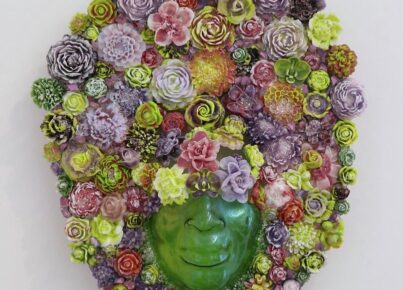[dropcap custom_class=”normal”] If you haven’t heard of Yinka Shonibare MBE (RA), here is your opportunity to briefly read up on him, and quickly do a search about all of his work, thoughts, and what he is about. Talk about TALENT (jaw dropping)! [/dropcap]
Yinka Shonibare MBE (RA) was born in London in 1962 of Nigerian parents who moved back to Lagos, Nigeria at the age of three.
He returned to London to study Fine Art first at Byam Shaw College of Art (now Central Saint Martins College of Art and Design) and then at Goldsmiths College, where he received his MFA, graduating as part of the ‘Young British Artists’ generation.
He currently lives and works in the East End of London.
One month into his art school studies he contracted a virus that rendered him paralyzed.
After three years of physical therapy, Shonibare remains partially disabled.
Over the past decade, Shonibare has become well known for his exploration of colonialism and post-colonialism within the contemporary context of globalisation.
Shonibare’s work explores these issues, alongside those of race and class, through the media of painting, sculpture, photography and, more recently, film and performance.
His paintings and his sculptural installations make extensive use of dyed fabrics, which became popular in West Africa after independence.
Using this wide range of media, Shonibare examines in particular the construction of identity and tangled interrelationship between Africa and Europe and their respective economic and political histories.
Mixing Western art history and literature, he asks what constitutes our collective contemporary identity today.
Having described himself as a ‘post-colonial’ hybrid, Shonibare questions the meaning of cultural and national definitions.
Shonibare was a Turner prize nominee in 2004 and was awarded the decoration of Member of the “Most Excellent Order of the British Empire”.
He has added this title to his professional name. In 2013 he was elected Royal Academician by the Royal Academy of Arts.
He was notably commissioned by Okwui Enwezor At Documenta 10 in 2002 to create his most recognised work ‘Gallantry and Criminal Conversation’ that launched him on an international stage.
He has exhibited at the Venice Biennial and internationally at leading museums worldwide.
In September 2008, his major mid-career survey commenced at the MCA Sydney and toured to the Brooklyn Museum, New York in June 2009 and the Museum of African Art at the Smithsonian Institution, Washington DC in October 2009 .
In 2010, ‘Nelson’s Ship in a Bottle’ became his first public art commission on the Fourth Plinth in Trafalgar Square.

 Some Of His Work
Some Of His Work

YINKA SHONIBARE GLOBE HEAD BALLERINA
Yinka Shonibare’s Globe Head Ballerina modelled on The Royal Ballet’s Melissa Hamilton.

NELSON’S SHIP IN A BOTTLE
At National Maritime Museum, Greenwich, London
Nelson’s Ship in a Bottle by Yinka Shonibare MBE is a 1:30 replica of Nelson’s flagship, HMS Victory, on which he died during the Battle of Trafalgar on 21 October 1805. It has 80 cannon and 37 sails set as on the day of battle.
The richly patterned sails were inspired by Indonesian batik, mass-produced by Dutch traders and sold in West Africa. Today these designs are associated with African dress and identity.
The characteristic bright colours and abstract symmetries of Dutch Wax fabric have accrued many complex, often ambivalent associations – with colonialism, industrialisation, emigration, cultural appropriation, and the invention (and reinvention) of tradition – all of which are foregrounded in Shonibare’s work.
Used for the rigging of Nelson’s Ship in a Bottle, the legacy of Dutch Wax assumes a further, distinctly maritime significance. He was nominated for the Turner Prize in 2004, the same year in which he was awarded an MBE (an appellation that he uses when exhibiting and signing works).
Currently on permanent display at National Maritime Museum, Greenwich, London

MCA CHICAGO PLAZA PROJECT: YINKA SHONIBARE MBE
16 June 2014 – October 2014

IKON ICON 1990S, LONDON
10 September — 9 November 2014
The series is a major component of Ikon 50, the programme of exhibition and events celebrating Ikon’s 50th anniversary.
Yinka Shonibare’s exhibition at Ikon in 1999 was seminal. It showed Five Under Garments and Much More (1995), an early suspended installation that prefigures the artist’s mannequin works.
Each piece mimics the structured corsetry of period noble dress but the dramatically enlarged proportions and exuberant textiles suggest a provocative de-robing of social and class constructions.
BUKKY ASEHINDE IS YOUR BIGGEST FAN!
Source: Stylepantry.com & yinkashonibarembe.com






